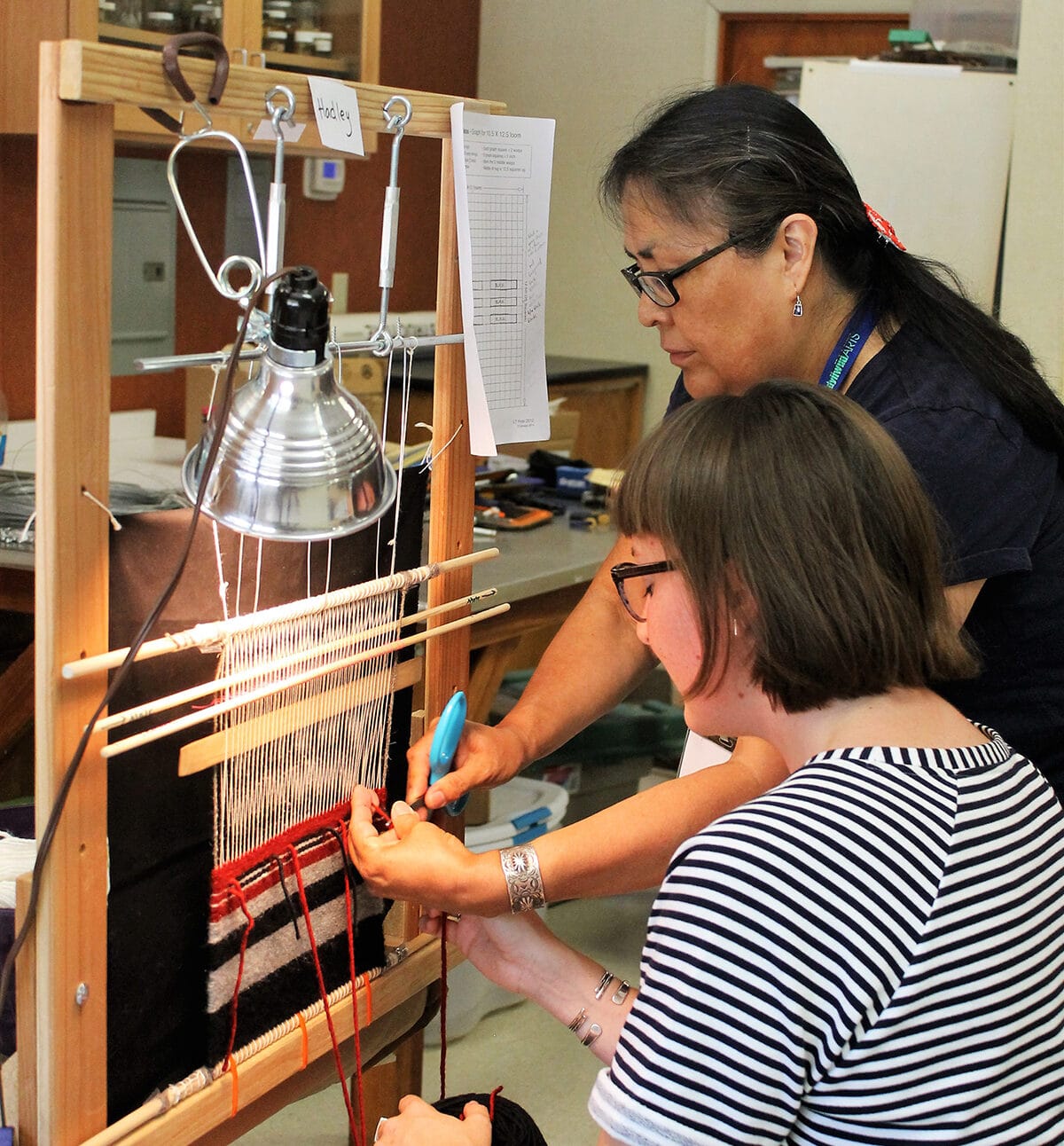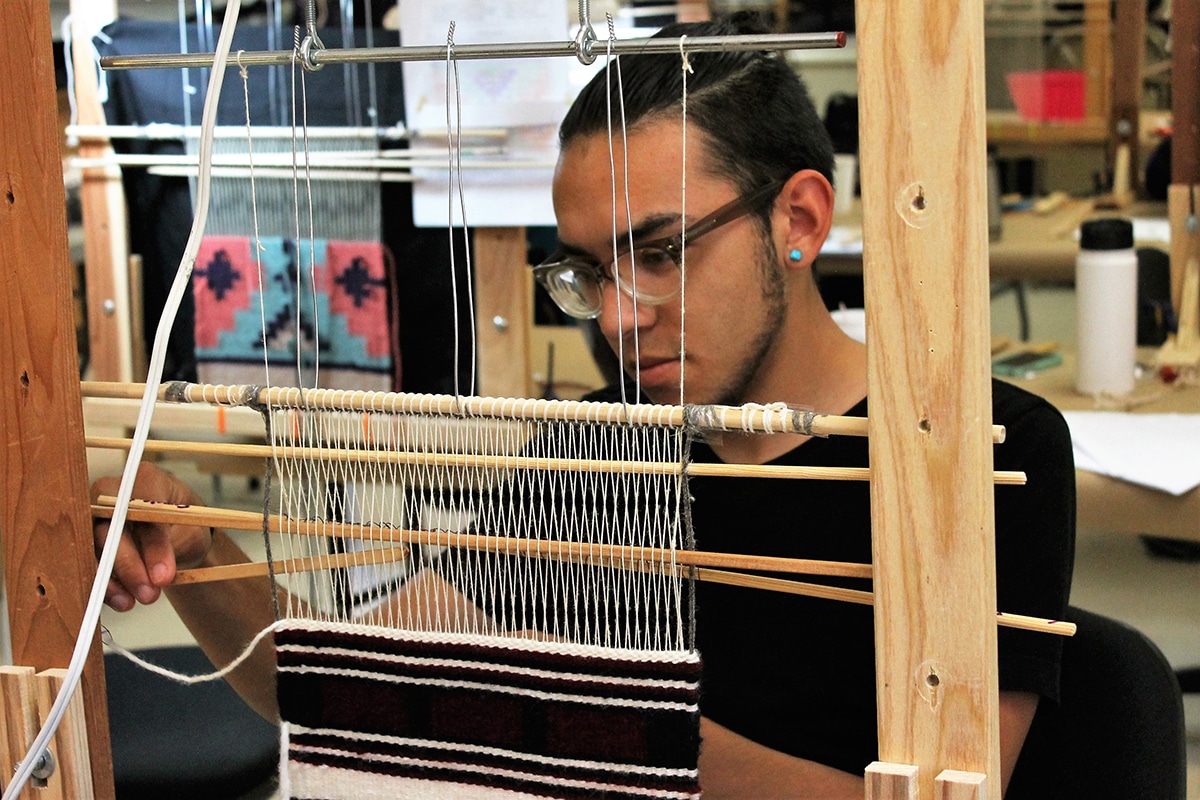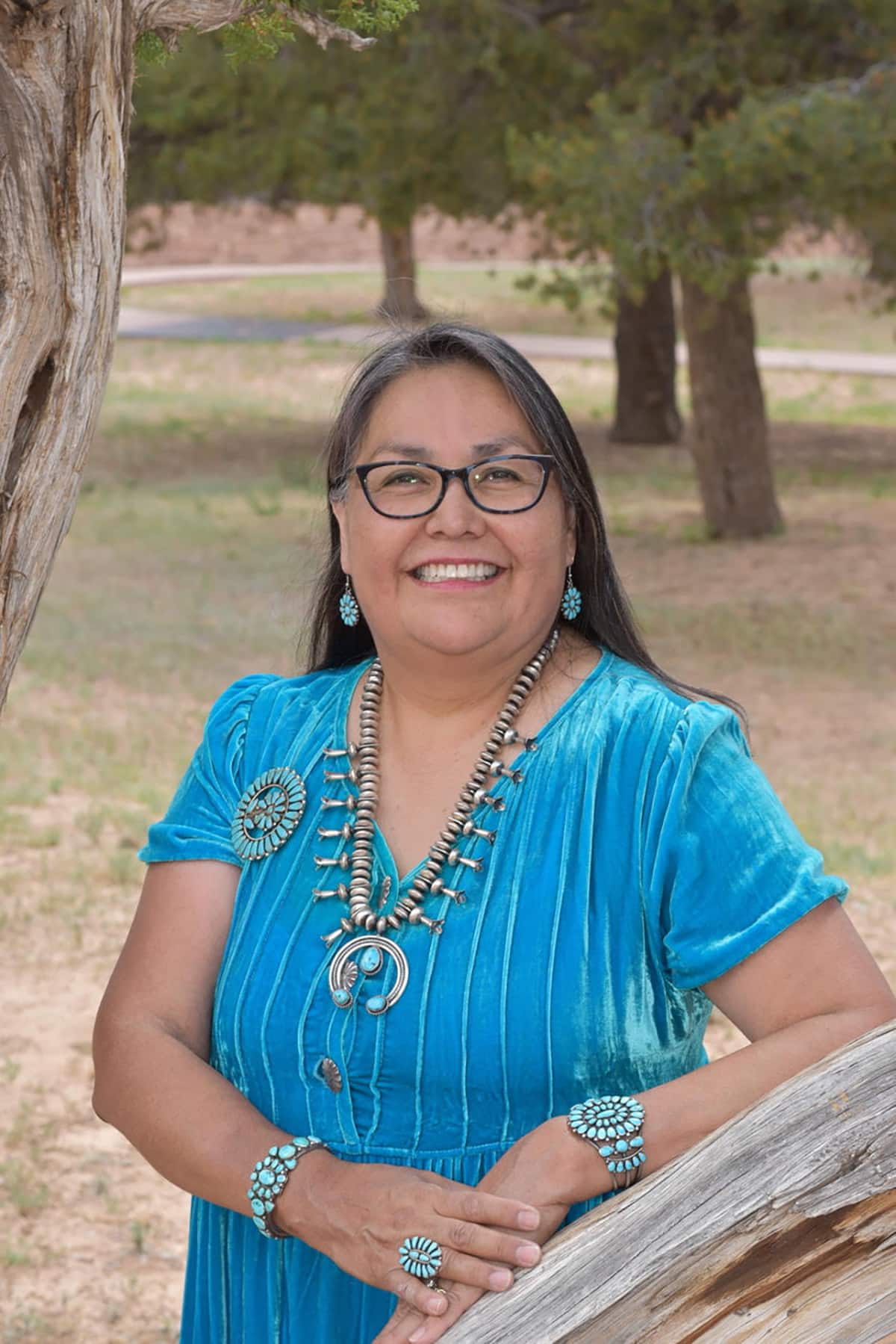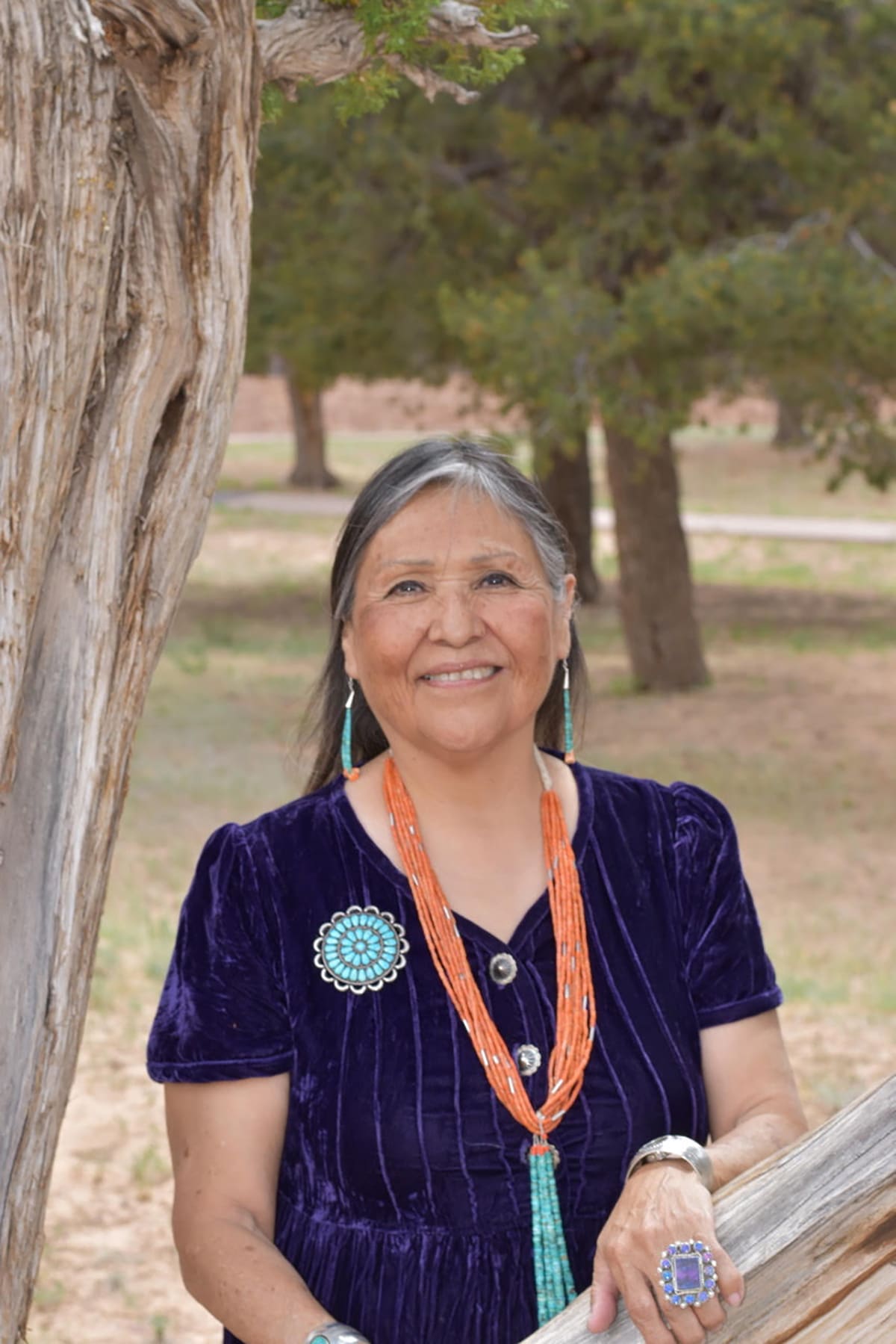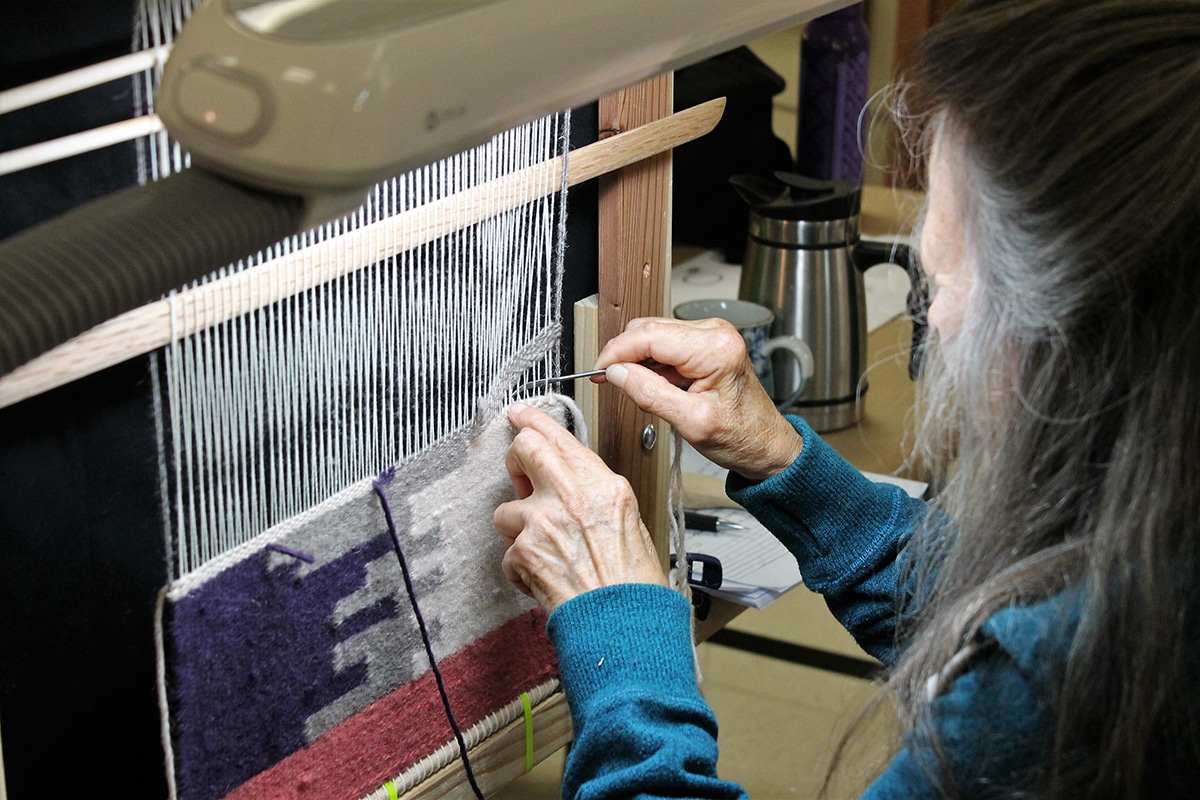Navajo Weaving I, II, & III
Learn the art of weaving from master Navajo weavers Barbara Teller Ornelas and Lynda Teller Pete, originally from Two Grey Hills and Newcomb, NM. While instructing and demonstrating, sisters Barbara and Lynda will share their family’s personal weaving stories and experiences, giving you a view into the world of Navajo weaving.
Beginners: Learn the traditional method of Navajo weaving and begin weaving with a pre-warped (8.5” wide X 10.5” high) upright Navajo loom. You will be provided with four skeins of wool of various colors and a kit with all items necessary to get started weaving. Extra materials will also be made available for purchase in class. The majority of the week will be spent designing and learning to weave an 8.5” wide x 10.5” high rug. This beginners session includes a lesson on warping a loom. You may enroll for the entire two or three weeks or only the first week.
Intermediate: If you have taken the course or have basic Navajo weaving training on an upright loom, you will explore more advanced techniques and patterns, and your rug may be any size. Bring weavings from previous summers to complete, or begin a new rug. You must bring your own loom and set it up for weaving before class begins. Or, you may order a pre-warped loom when registering online. This session, as well as the advanced session, includes a special lesson on warping. You may enroll for the entire three weeks or only the second week.
- Dyeing Your Wool: Special Treat for Week II / Intermediate and Week III / Advanced Weaving Students!
Navajo weavers in regional areas of the Navajo Nation have been dyeing wool for their weavings to create beautiful rugs, tapestries, throws, and blankets. Early Navajo weavers began using natural plant dyes as far back as the 1700s and have continued to employ varying methods to produce an array of colors, shades, tints, and hues. Plants are gathered according to seasons to get different hues. We use kitchen scraps and dried dye matter in modern times and grind them before use. Students will choose white wool or colored wool for over-dyeing and tie and immerse it in an alum solution. On the second day, we will extract dye by boiling onion skins, Navajo tea, cochineal, logwood, and brazilwood and cool them in stainless steel pots. On the third day, we will immerse the wool, and students can get a chance to experiment with their dyeing. All supplies and equipment are provided with a $20 supplies fee when registering online.
Advanced: Advanced students are encouraged to complete larger works from previous classes or summers. In this advanced class, you will have the unique opportunity to immerse yourself in a deeper study of Navajo weaving techniques. This class will introduce weaving techniques such as diagonals and pictorials and share information about the mathematics employed to execute intricate weaving designs. An in-depth study will provide the vital context of the importance of Navajo weaving in Navajo culture historically and today. Barbara and Lynda will also lead discussions on Navajo trading post styles, abstracts, landscapes, and period pieces from the mid-1800s. At the end of class, you will get to take home your finished rug(s) and have a more profound knowledge of Navajo weaving.
- Dyeing Your Wool: Special Treat for Week II / Intermediate and Week III / Advanced Weaving Students!
Navajo weavers in regional areas of the Navajo Nation have been dyeing wool for their weavings to create beautiful rugs, tapestries, throws, and blankets. Early Navajo weavers began using natural plant dyes as far back as the 1700s and have continued to employ varying methods to produce an array of colors, shades, tints, and hues. Plants are gathered according to seasons to get different hues. We use kitchen scraps and dried dye matter in modern times and grind them before use. Students will choose white wool or colored wool for over-dyeing and tie and immerse it in an alum solution. On the second day, we will extract dye by boiling onion skins, Navajo tea, cochineal, logwood, and brazilwood and cool them in stainless steel pots. On the third day, we will immerse the wool, and students can get a chance to experiment with their dyeing. All supplies and equipment are provided with a $20 supplies fee when registering online.
According to Navajo oral tradition, two holy people, Spider Woman and Spider Man introduced weaving to the Navajo. Spider Man constructed the first loom, which was composed of sunshine, lightning, and rain, and Spider Woman taught the people how to weave on it. Spider Woman was discovered by the Holy Twins, the culture heroes of the Navajo Creation Story, in a small opening in the earth surrounded by an array of beautiful weavings. Entering her dwelling, the Holy Twins descended a ladder made of yarn, at which point Spider Woman offered them knowledge of the world of weaving.
You are invited to enroll in the class (or classes) that best fits your skill level. Please read below for more information abouts suggested items to bring to class.
Optional:
- Padded cushion for your seat
- Back support device
- Clamp on light
- Clip on fan for comfort
- Reading glasses if necessary
Barbara Teller Ornelas (Diné) is best known for her ultra-fine Navajo tapestry weavings (95–120 weft threads per inch). She has set several records with her weavings, winning Best of Show twice at the Santa Fe Indian Market. She set a new record in 1987 by selling a weaving for $60,000 that she and her sister Rosann Lee made; this historic weaving is the largest tapestry-style Navajo weaving on record. Barbara is a fifth-generation weaver raised near Two Grey Hills, AZ, on the Navajo Nation. Barbara and her work are featured in many publications including, National Geographic, Business Week, Americana, Native American Art, and First American Art Magazines, among many others. She has won dozens of awards and has demonstrated and lectured at many museums and institutions worldwide.
Lynda Teller Pete (Diné) began weaving at age six and won her first major award at age 12 at the Gallup Inter-tribal Ceremonial Art Show in Gallup, New Mexico. She has gone on to win many awards for her weaving, including Best of Classification for Textiles at the prestigious Santa Fe Indian Market. Lynda collaborates with museums, schools, and art venues in Colorado and the country to teach about Navajo weaving. She is also known as an accomplished beadwork artist and has won many awards for this work. Barbara and Lynda published their first book, Spider Woman’s Children: Navajo Weavers Today, in 2018.
Native American & Inland Empire Teacher Scholarships
We recently made some changes to our scholarship application process.
Generous donors have made scholarships and fellowships for adult workshops available on a limited basis for these specific groups:
- Native American Community Leaders, Artists, Members, and Teachers
- Inland Empire Teachers, Professors, and Graduate Students
Scholarships include tuition, lab fee, dorm housing, and all meals provided by the campus dining service. We believe in allowing everyone a chance to experience the transformative power of art at Idyllwild Arts. In order to reach as many as possible with this opportunity we are happy to extend each applicant one scholarship. These scholarships are designed to provide access to arts based educational opportunities that will advance your personal and professional development as well as the Indigenous community(ies) you come from. You are responsible for paying the $50 application fee and transportation to and from campus. A short essay (200 to 750 words) expressing how this opportunity will benefit you and your community is required, we want to hear from you! We also ask that you provide screenshots of your last two W2s so that the scholarship committee can identify financial need and assess the scholarship amount to be offered. We are pleased to offer scholarships in two categories.
- Full Scholarship: students receive meals, housing, and tuition and lab fee (room and board if applicable).
- Half Scholarship: students receive approximately half off their tuition (room and board if applicable)
For more detailed information and a Scholarship FAQ please read Adult Scholarships FAQs.
Scholarship Details:
- Native American Community Members, Leaders, Artists, and Teachers
For adults 19 and older with current tribal affiliation, the scholarship brings community leaders, artists, members, and teachers to workshops at Idyllwild Arts to benefit both the scholarship recipients themselves and those in their schools or tribal communities. Applicants who demonstrate financial need may receive priority. We also offer scholarships for Native American Teens for both the Summer Program and the Academy. - Inland Empire Teachers, Professors, and Graduate Students
For teachers and graduate students from the Inland Empire (Riverside and San Bernardino Counties and the adjacent areas), this scholarship brings teachers and graduate students to Idyllwild Arts to attend Native American Arts workshops. The Native American Arts Workshops benefit both recipients and their students and communities, providing culturally appropriate instruction and professional development to teachers and graduate students. Applicants with financial needs may receive priority. These scholarships are made possible through the generous support of the San Manuel Band of Serrano Mission Indians.
Click here for more information about adult scholarships.
Age: 19 years and above
Dates:
Session I: June 12-16, 2023
Session II: June 19-23, 2023
Session III: June 26-30, 2023
Tuition, room, and board (each session): $1,719
Day student tuition (each session): $840
Beginner Lab Fee: $100, includes the use of a pre-warped loom, all tools in class, and four skeins of wool. Looms, additional wool, battens, and combs will be available for purchase.
Intermediate/Advanced Lab Fee: $20 Lab Fee
$80 (optional), pre-warped loom
Enrollment is limited to 12 students.
Faculty: Barbara Teller Ornelas & Lynda Teller Pete


